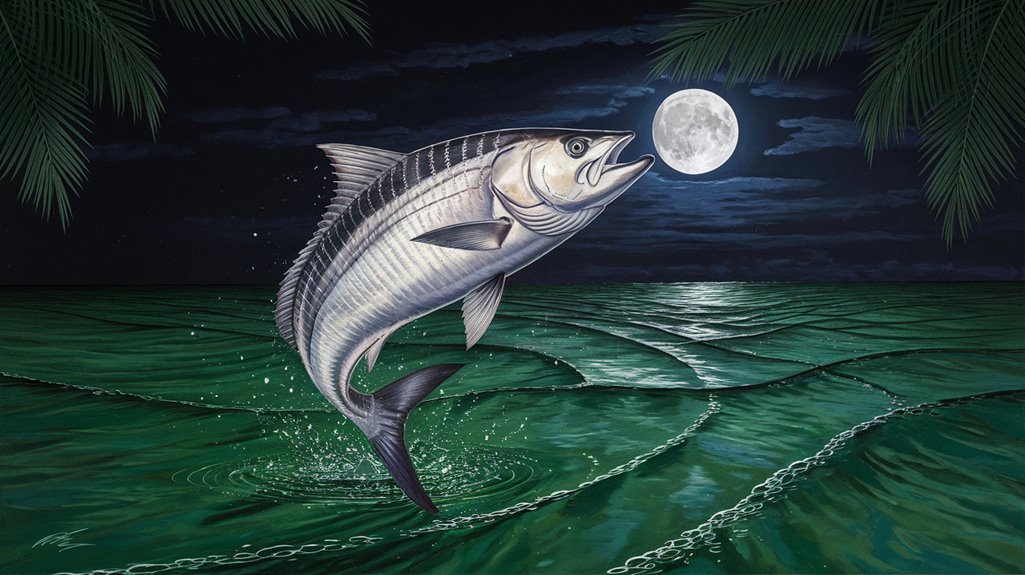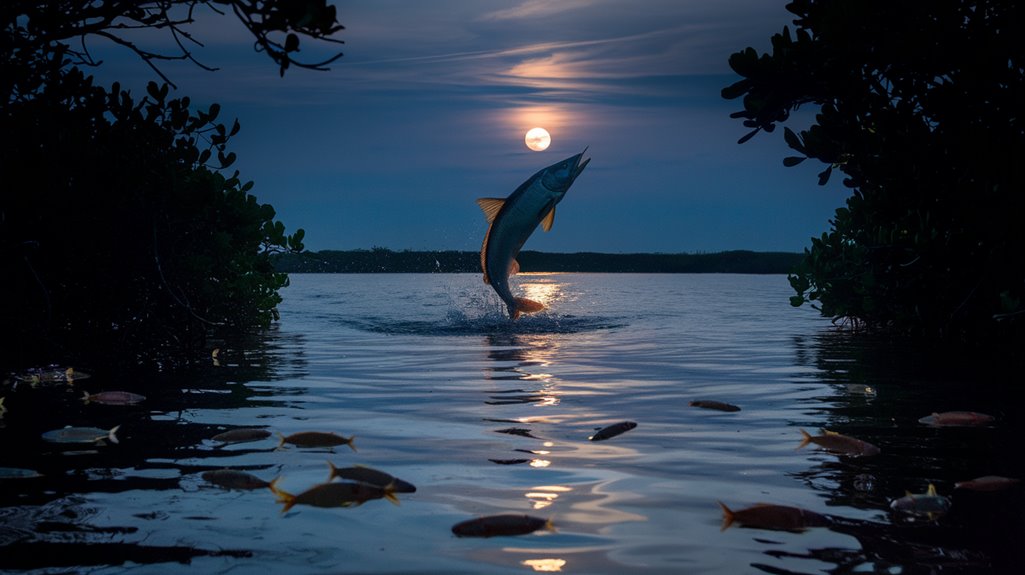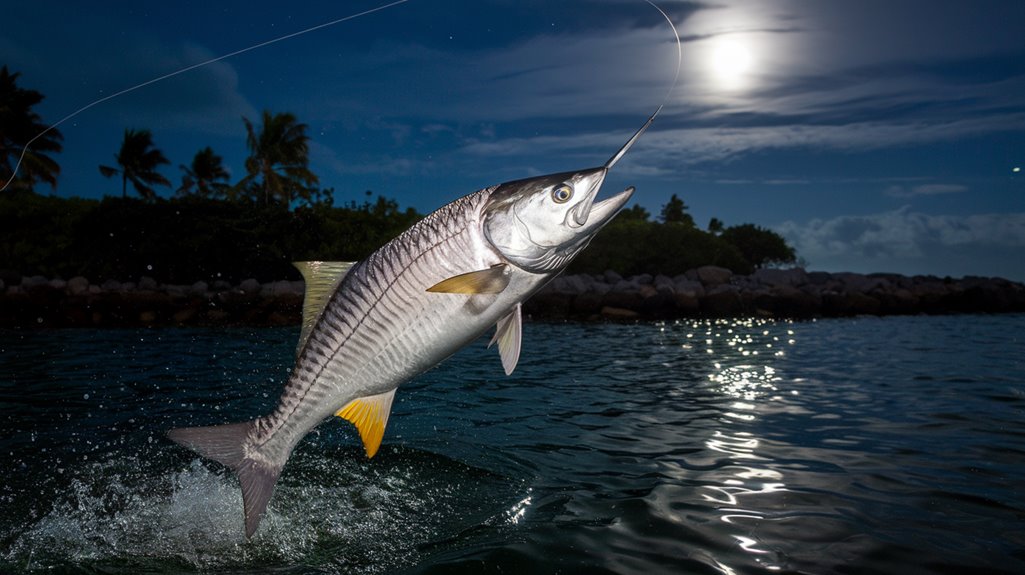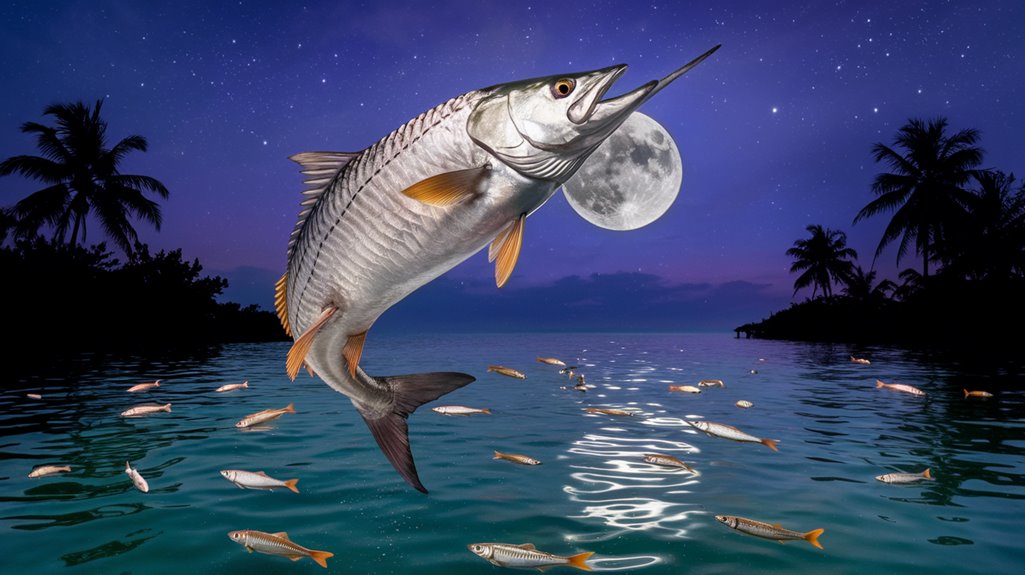You’ll find that tarpon fishing success hinges heavily on understanding lunar and tidal interactions. These prehistoric gamefish respond to gravitational forces that affect water movement, bait positioning, and feeding patterns throughout their habitat. During full and new moons, tidal flows can increase by up to 40%, dramatically altering fishing conditions and tarpon behavior. To maximize your catch rate, you’ll need to grasp these essential astronomical influences and their direct impact on tarpon movements.
- Key Takeaways
- Understanding Moon Phases and Their Impact on Tarpon Behavior
- Navigating Tidal Movements for Peak Fishing Success
- Weather Patterns That Influence Tarpon Feeding Times
- Strategic Locations Based on Lunar and Tidal Cycles
- Essential Techniques for Different Moon-Tide Combinations
- Frequently Asked Questions
- Conclusion
Key Takeaways
- Full moons increase tarpon’s nocturnal feeding activity while reducing daytime bites, making night fishing more productive during this phase.
- Strong tidal flows during full and new moons concentrate tarpon around creek mouths and points for feeding opportunities.
- Incoming tides push baitfish toward creek mouths and sandbars, creating prime tarpon fishing locations.
- Outgoing tides force tarpon into deeper channels and passes, where they ambush prey in concentrated areas.
- Slack tides result in reduced tarpon activity, while spring tides near new and full moons create optimal fishing conditions.
Understanding Moon Phases and Their Impact on Tarpon Behavior

While moon phases have long fascinated anglers, their influence on tarpon behavior is rooted in scientific observation and documented patterns. You’ll notice distinct changes in tarpon activity throughout lunar cycles, with full moons triggering increased nocturnal feeding activity but potentially reducing daytime bites. The moon’s gravitational pull creates stronger currents and enhanced tidal flows, particularly during full and new moons, which concentrates tarpon around creek mouths and points.
Water temperature around 79°F combines with these lunar influences to affect migration patterns. You’ll find that mid-phase moons often provide more consistent fishing opportunities, as tarpon behavior becomes more predictable. To optimize your fishing strategies, you’ll need to adapt your approach based on specific moon phases, considering how these celestial cycles impact both tides and feeding activity.
Navigating Tidal Movements for Peak Fishing Success
When tarpon congregate near creek mouths and sandbars during incoming tides, they’re capitalizing on the surge of baitfish moving into shallower waters. You’ll find ideal fishing success by targeting these predatory feeding zones during strong tidal flows.
During outgoing tides, you should shift your focus to deeper channels and passes where tarpon actively ambush prey in swift currents. Slack tides typically yield reduced fish behavior and feeding activity, so you’ll want to align your fishing schedule with peak tidal movements. The strongest tidal flows occur during full and new moons, creating prime fishing conditions. To maximize your tarpon fishing results, you must analyze local weather conditions and adapt your approach based on specific tidal patterns. This systematic understanding of tidal dynamics directly correlates to increased catch rates.
Weather Patterns That Influence Tarpon Feeding Times

Understanding barometric pressure changes proves vital for predicting ideal tarpon fishing conditions. You’ll notice increased aggressive feeding behavior when the barometric pressure suddenly drops, particularly just before storms approach. During these pre-storm periods, tarpon intensify their feeding patterns, creating prime fishing opportunities.
East winds create favorable inshore fishing conditions, as they generate calm waters that enhance tarpon activity. Light to moderate winds disturb the surface, making it easier to attract tarpon upward. However, you’ll need to adjust your strategy during heavy rain, as tarpon typically retreat to deeper waters, reducing their presence in shallow areas. By monitoring these weather patterns alongside tidal movements, you can maximize your chances of success. The relationship between weather conditions and tarpon behavior directly impacts their feeding phases, making weather awareness vital for productive fishing sessions.
Strategic Locations Based on Lunar and Tidal Cycles
Strategic tarpon fishing locations shift dramatically with lunar and tidal cycles, requiring precise positioning during specific moon phases. You’ll find ideal fishing conditions during spring tides, particularly near new and full moons, when water movement intensifies along the Gulf Coast. These lunar-driven tidal swings create prime fishing spots where you can target tarpon effectively.
- Position at creek mouths during incoming tides to intercept baitfish schools
- Target deeper channels like the Skyway Bridge during outgoing tides
- Focus on points and sandbars during peak moon phases
- Adjust locations based on wind direction and water clarity
- Select spots near passes during strong tidal flows
Monitor these locations during spring and full moon periods when tarpon activity peaks, maximizing your chances of success by aligning with natural feeding patterns.
Essential Techniques for Different Moon-Tide Combinations

Different moon-tide combinations demand specific angling approaches to maximize your tarpon fishing success. During full moons, you’ll want to concentrate your efforts on nighttime fishing when tarpon actively feed in the enhanced visibility. Target creek mouths and shallow waters during incoming tides, as these areas concentrate baitfish, attracting hungry tarpon.
When fishing outgoing tides, particularly during new moon phases, position yourself near deeper channels where water movement creates prime ambush points. You’ll need to adapt your technique based on tidal movements, using baitfish-mimicking lures during strong currents. For ideal results, monitor weather patterns alongside phases of the moon, as stable conditions combined with strategic timing of tides can greatly improve your catch rate. Match your fishing locations and techniques to these natural cycles for consistent success.
Frequently Asked Questions
What Is the Best Moon Phase for Tarpon Fishing?
You’ll find ideal tarpon fishing during the days surrounding a full moon, though pre-full moon periods offer peak activity. New moons provide alternative opportunities through enhanced tidal movements.
What Is the Best Tide to Catch Tarpon?
You’ll find incoming tides are ideal for tarpon fishing, as they push baitfish into shallow areas. Outgoing tides rank second-best, creating ambush opportunities in deeper channels and passes.
What Is the Best Moon and Tide for Fishing?
You’ll achieve ideal fishing during strong incoming or outgoing tides coinciding with new moon phases. Water temperatures of 75-85°F and peak tide swings maximize your success across various species.
Is It Better to Fish on a Full Moon or New Moon?
You’ll find success during both phases, with full moons creating stronger currents for night fishing, while new moons offer ideal daytime conditions with less light disturbance and significant tidal movements.
Conclusion
You’ll maximize your tarpon fishing success by synchronizing your efforts with lunar-tidal interactions. During full and new moons, concentrate on creek mouths where tidal flows reach 20-30% higher velocities. Target feeding zones during incoming tides (+1 to +4 feet) and shift to deeper channels (15-30 feet) during outgoing phases. Monitor barometric pressure fluctuations above 30.1 inches for ideal feeding windows, particularly during dawn and dusk changes.

